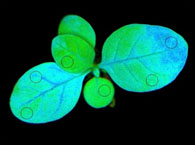Manager
Anja Krieger-Liszkay
To protect themselves against oxidative damage plants have developed a number of mechanisms that lead to heat dissipation (so-called non-photochemical quenching; NPQ), to the activation of alternative electron transport pathways and to changes in the antioxidant system including antioxidants (e.g. ascorbate, carotenoids) and antioxidant enzymes (e.g. catalase, ascorbate peroxidase). Despite playing a damaging role, ROS are highly important for certain developmental processes like germination and extension growth. We are using biophysical, biochemical and genetic approaches to study the regulation of photosynthetic electron transport and the sites and molecular mechanisms of ROS generation.
Our work focusses especially on the responses of plants to varying light conditions and to light acclimation processes in the short- and long-term. Beside this, ROS generation at the level of the plasma membranes will be further be studied.

ROS production and signalling Environmental stress is perceived primarily in the chloroplast by perturbations of the photosynthetic electron flow which lead to an increased ROS production. At the same time the redox state of the chloroplast is sensed by the reduction of thioredoxin. According to our model, thioredoxins and related thiolreactive molecules reversibly down-regulate the activity of ROS detoxifying enzymes and thereby allow a transient oxidative burst that triggers the expression of ROS responsive genes.
Alternative electron transport: characterization of the plastid terminal oxidase PTOX The amount of PTOX increases under conditions of oxidative stress. PTOX oxidses plastoquinol by transferring electrons to O2 and generating water. PTOX activity may be important to set the redox poise of the photosynthetic electron transport chain under stress condition. We have biochemically characterized PTOX and established a functional reconstitution system using photosystem II and PTOX. At present, we are studying the  physiological role pf PTOX.
physiological role pf PTOX.
Role of ROS in germination and extension growth We have characterized the ROS-generating enzymes of the plant plasma membrane. We have shown that beside NADPH oxidases quinone reductases are an important source of ROS. At present we characterize mutants of different quinone reductases in
A. thaliana.